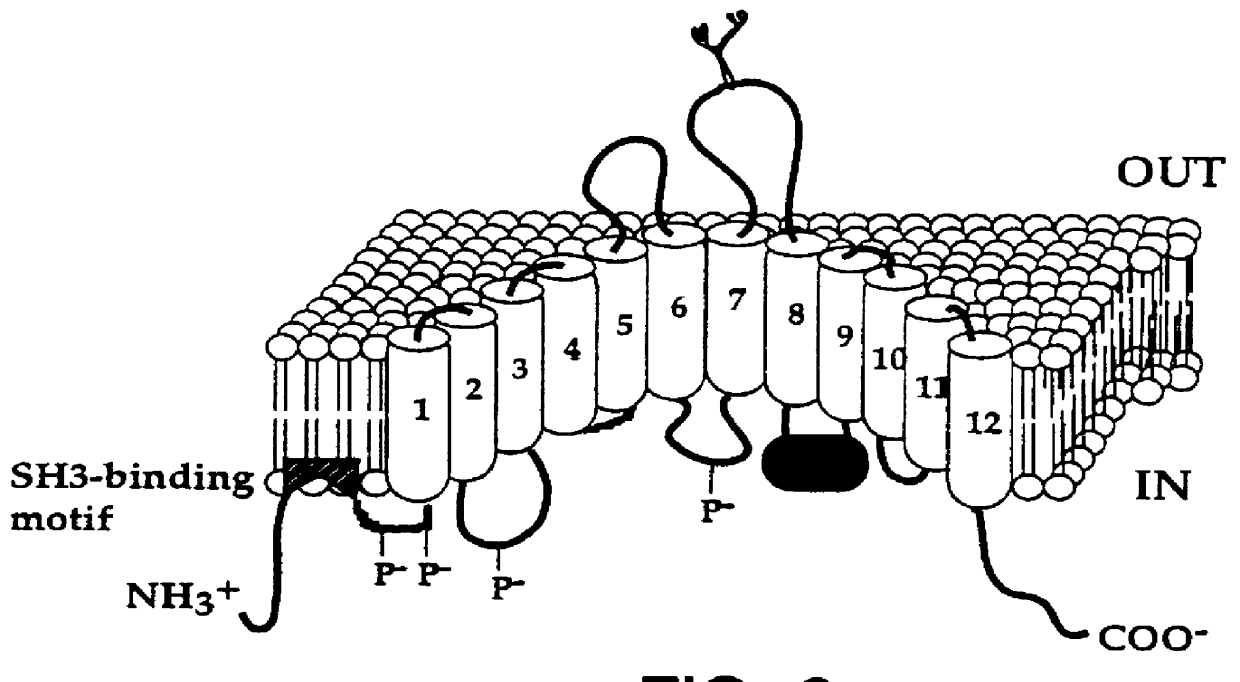Method of identification of animals resistant or susceptible to disease such as ruminant brucellosis, tuberculosis, paratuberculosis and salmonellosis
a technology of brucellosis and brucellosis, which is applied in the field of identification of animals resistant or susceptible to disease such as brucellosis and tuberculosis, which can solve the problems of inability to identify the disease, etc., to achieve the effect of simple technology, high degree, and easy identification
- Summary
- Abstract
- Description
- Claims
- Application Information
AI Technical Summary
Benefits of technology
Problems solved by technology
Method used
Image
Examples
example 2
Analysis of the Predicted Bovine NRAMP1 Structure
Note that as used herein, it is understood that the term "NRAMP1" includes the coding sequence and at least the 3' UTR of the gene. The first 64 N-terminal amino acids of Bovine NRAMP1 are rich in proline (11 / 64), glycine (10 / 64), serine (8 / 64), and charged amino acids (10 / 64), and include two putative PKC phosphorylation sites at amino acid positions 37 and 51 (FIG. 2). Because SH3 domains interact specifically with proline-rich peptides, we compared the proline-rich coding fragment PPSPEP (positions 21-26) to several identified SH3- binding sequences (Lim et al. 1994). The analysis revealed that the "PNNP" binding motif (Musacchio et al. 1994) is conserved in bovine Nramp1, which indicates that bovine Nramp1 contains an N-terminal SH3 binding domain. Kyte-Doolittle hydrophilicity analysis (FIG. 5) disclosed that the surface probability of peptide PPSPEP is from 50.3% to 67.6%, which indicates that the bovine Nramp1 SH3-binding motif...
example 3
Homology Among Human, Murine, and Bovine Nramp Proteins
Comparison of human, murine and bovine predicted Nramp protein sequences (FIG. 2) indicates a remarkable degree of homology (86.9% amino acid sequence identity between murine and bovine; 88.6% amino acid sequence identity between human and bovine). The predicted TM segments 1-8 are highly conserved hydrophobic membrane associated domains in the three species, with 99% identity between human and bovine, and 96% identity between murine and bovine. The most conserved consecutive region is from TM 8-9 with 100% identity from position 346 to 456 between human and bovine; 98.2% identity between murine and bovine. Within the TM 8-9 segment, the bovine "binding protein dependent transport system inner membrane component signature" was identical with murine and human Nramp with one exception (substitution of lysine to arginine at position 392 in the human (FIG. 2). Also among these three species, one predicted N-linked glycosylation site...
example 4
Genetic Mapping of Bovine NRAMP1
Genetic Mapping was performed as follows. Bovine-hamster hybrid somatic cell panel blots (Womack et al. 1986; Adkinson et al. 1988; Beever et al. 1994) were hybridized with the 1F / 1R PCR generated probe (4-8.times.10.sup.8 cpm / .mu.g) (Feinberg et al. 1983). Hybridization was performed at 43.degree. C. for 18 hrs in 20 ml of 50% formamide, 5.times.SSC, 1.times.Denhardt's solution, and 20 mM NaPO.sub.4 (pH-6.8), followed by washing once in 2.times.SSC, 0.5% SDS at room temperature for 15 min., two successive washes in 1.times.SSC, 0.1% SDS at 65.degree. C. for 30 min (Adkinson et al. 1988). All gene probes were labeled with the random primed DNA labeling method is .alpha.-[.sup.32 P] dCTP (3000 Ci / mmol) (NEN Research Products, Boston, Mass. (Feinberg et al. 1983). Synteny was ascertained by analysis of concordancy of the probe with known marker genes as described (Womack et al. 1986; Adkinson et al. 1988; Womack et al. 1994).
The syntenic arrangement of ...
PUM
| Property | Measurement | Unit |
|---|---|---|
| volume | aaaaa | aaaaa |
| volume | aaaaa | aaaaa |
| temperature | aaaaa | aaaaa |
Abstract
Description
Claims
Application Information
 Login to View More
Login to View More - R&D
- Intellectual Property
- Life Sciences
- Materials
- Tech Scout
- Unparalleled Data Quality
- Higher Quality Content
- 60% Fewer Hallucinations
Browse by: Latest US Patents, China's latest patents, Technical Efficacy Thesaurus, Application Domain, Technology Topic, Popular Technical Reports.
© 2025 PatSnap. All rights reserved.Legal|Privacy policy|Modern Slavery Act Transparency Statement|Sitemap|About US| Contact US: help@patsnap.com



